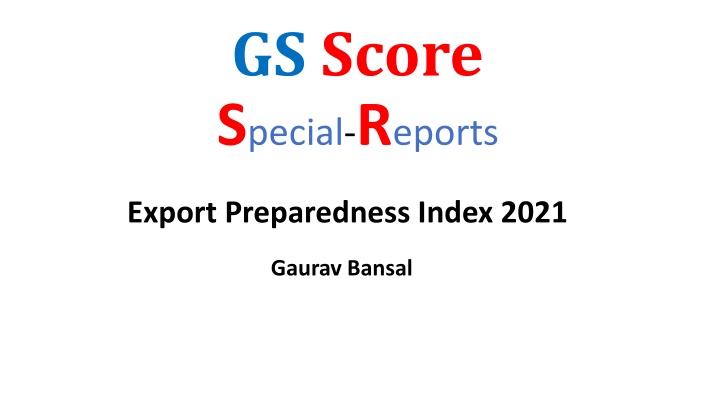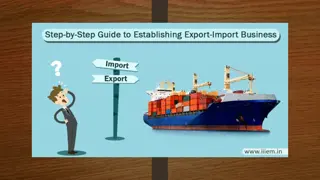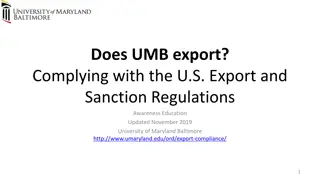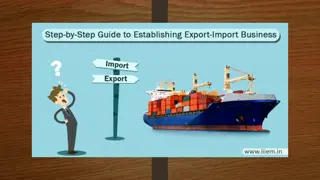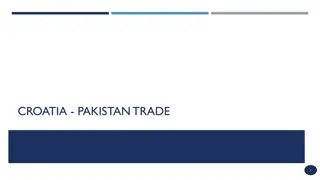Export Preparedness Index 2021: Insights and Rankings
The Export Preparedness Index 2021, published by NITI Aayog in collaboration with the Institute of Competitiveness, aims to enhance competition among Indian states to boost export promotion policies. The report evaluates states on key pillars like trade policy, business ecosystem, export ecosystem, and export performance. Rankings show coastal states excelling, with Gujarat leading the pack. The index encourages healthy competition and offers strategic recommendations for improving export competitiveness and enhancing India's global standing.
Download Presentation

Please find below an Image/Link to download the presentation.
The content on the website is provided AS IS for your information and personal use only. It may not be sold, licensed, or shared on other websites without obtaining consent from the author.If you encounter any issues during the download, it is possible that the publisher has removed the file from their server.
You are allowed to download the files provided on this website for personal or commercial use, subject to the condition that they are used lawfully. All files are the property of their respective owners.
The content on the website is provided AS IS for your information and personal use only. It may not be sold, licensed, or shared on other websites without obtaining consent from the author.
E N D
Presentation Transcript
GS Score Special-Reports Export Preparedness Index 2021 Gaurav Bansal
Export preparedness index 2021 Export preparedness index 2021 Published by: NITI Aayog, in partnership with the Institute of Competitiveness. Aim and Objective The Export Preparedness Index is a data-driven endeavor to identify the fundamental areas critical for sub- national export promotion. The index can be used by states and union territories to benchmark their performance against their peers and analyze potential challenges to develop better policy mechanisms to foster export-led growth at the subnational level. The EPI s primary goal is to instill competition among all Indian states ( Coastal , Landlocked , Himalayan , and UTs/City-States ) to bring about favorable export-promotion policies, ease the regulatory framework to prompt subnational export promotion, create the necessary infrastructure for exports, and assist in identifying strategic recommendations for improving export competitiveness. It promotes competitive federalism and a fair contest among States/UTs. The index can be a valuable tool for the government and policymakers in encouraging healthy competition among states and UTs, hence enhancing India s standing in the global export market.
Parameters of the Report Parameters of the Report The EPI ranks states and UTs on 4 main pillars and 11 sub-pillars Trade Policy (Export Promotion Policy; Institutional Framework) 20% weightage Business Ecosystem (Business Environment; Infrastructure; Transport Connectivity; Access to Finance) - 40% weightage Export Ecosystem (Export Infrastructure; Trade Support; R&D Infrastructure) 20% weightage Export Performance: only output-based parameter, which looks into actual performance of states (Export Diversification; and Growth Orientation) 20% weightage
Parameters of the Report Parameters of the Report
Parameters of the Report Parameters of the Report
The Rankings Outcome: The 2021 edition has shown that most of the Coastal States are the best performers, with Gujarat as the top-performer. Ranking: Gujarat has been named India s top State in terms of export preparedness followed by Maharashtra, Karnataka, Tamil Nadu. In the category of Landlocked States , Haryana was the best-performing state. Among Himalayan States and Union Territories , Uttarakhand and Delhi are the top-performing states respectively. Implications: States with higher exports also experience a high Gross State Domestic Product (GSDP). 16 states out of 36 states/UTs have scored above the national average in the Export performance pillar. Their performance has varied drastically for two reasons: Regional Export Disparity, as coastal states continue to dominate the export sector across states of India. Another reason is that indicators have been evaluated relative to their exports contribution to its GDP, which impacts scores of smaller regions.
Challenges in Indias Export Situation The EPI has identified three major challenges to India s export: o Intra- and inter-regional differences in the export infrastructure of different states o Weak trade support system & growth orientation and; o Lack of proper research and development infrastructure According to DST 2019-20 data, it has been observed that all the states of India spend less than 1 per cent of their R&D expenditure relative to its state gross domestic product. Trade support remains a low-scoring sub-pillar. One of the reasons is that states lag in identifying key trade facilitation issues, conducting capacity building workshops and no approved projects under TIES (Trade Infrastructure for Export Scheme). Growth and orientation remain the second lowest sub-pillar reflection of regional disparity in export growth. There is a considerable gap in the national average and an average score of coastal states like Gujarat and Maharashtra, reflecting their higher contribution to the overall export growth of India.
Suggestions to increase Exports of States and UTs Existing export infrastructure needs to be improved by introducing Export promotion hubs & SEZ and agriculture export zones in the regions and making trade guides more transparent and accessible with relevant export information. States should also work on improving access to information. States need to identify key trade facilitation issues in strategic policies and further assess capacity building/orientation workshops to ensure trade support to exporters in the region. States must work on providing higher credit to exporters by increasing the banking facilities in the region relative to its population. States which have a higher percentage of the banking facilities in the region have performed better, despite low FDI inflow. Industrial land and internet facilities are important as they reflect robust infrastructure for supporting the environment for exports. Moreover, states with high cluster strength have a lot of potential to promote the clusters and accelerate their exports. Apart from identifying specific export promotion policy measures, it is required to build the necessary infrastructure like State Center coordination cells, grievance redressal cells, access to an export committee and international markets.
Suggestions to increase Exports of India India s specialization has become more skilled intensive in exports of auto and auto parts, electronics, machinery, pharmaceuticals in contrast to opposite belief. India has not fully exploited the Lewis curve for low skill manufacturing compared with more skill intensive exports. Low/ Un- skilled exports include apparel, textiles, leather, and footwear. Since the nation has a comparative advantage in low skilled exports, it must boost its manufacturing capacity to further exploit this opportunity. India s One District One Product scheme can be used by states to include traditional products, such as textile, to scale up existing industries around the low skilled driven labor. This will ensure that quality products are manufactured; it further can boost domestic supply and drive increased exports of such products. The Indian export sector requires timely technology upgradation and upskilling of the labor force to promote efficiency. Further, investment in R&D and design are important to encourage Indian exporters to shift focus from exporting raw materials and intermediary goods to complex and unique economic goods for long term sustainable export growth.
